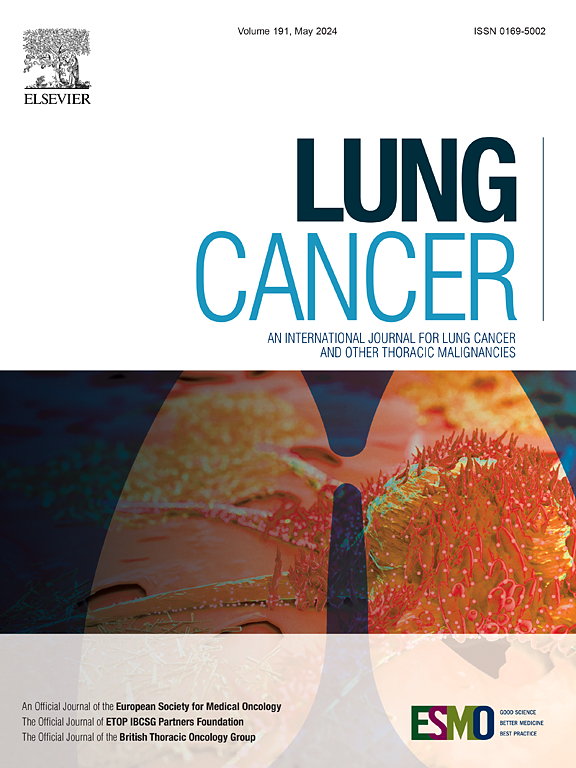免疫检查点抑制剂治疗ttf -1阴性非鳞状NSCLC中HNF4α表达对预后的影响
IF 4.5
2区 医学
Q1 ONCOLOGY
引用次数: 0
摘要
甲状腺转录因子-1 (TTF-1)阴性状态与免疫检查点抑制剂(ICI)应答不良相关;然而,根本原因尚不清楚。肝细胞核因子4α (HNF4α)是一种与TTF-1互斥的核受体,与癌细胞的增殖和转移有关。本研究评估了HNF4α表达对接受ICI治疗的ttf -1阴性非鳞状非小细胞肺癌(non-Sq NSCLC)患者生存结局的影响。方法我们进行了这项单中心回顾性研究,分析了接受ICI治疗的晚期或复发性非sq NSCLC患者。根据免疫组化分析将患者分为三组:(1)TTF-1阴性和HNF4α阳性,(2)TTF-1阴性和HNF4α阴性,(3)TTF-1阳性。采用Kaplan-Meier分析估计总生存期(OS),采用log-rank检验比较组间差异。结果共纳入388例ICI患者:TTF-1阴性HNF4α阳性54例,TTF-1阴性HNF4α阴性48例,TTF-1阳性286例。ttf -1阴性hnf4 α-阳性组的中位OS明显低于ttf -1阳性组(12.0 vs 32.3个月;风险比(HR): 2.14[95%置信区间(CI): 1.54-2.99], p <;0.001)。同时,ttf -1阴性hnf4 α-阳性组的中位OS与ttf -1阳性组相当(32.2个月vs 32.3个月;HR: 1.03 [95% CI: 0.68-1.54], p = 0.90)。多因素分析表明,HNF4α是一个独立的不良预后因素。仅限于腺癌患者和接受一线化学免疫治疗的患者的亚组分析显示出类似的趋势。结论ttf -1阴性非sq NSCLC中hnf4 α表达与ICI患者预后不良相关。本文章由计算机程序翻译,如有差异,请以英文原文为准。

Prognostic impact of HNF4α expression in TTF-1-negative non-squamous NSCLC treated with immune checkpoint inhibitor
Introduction
Thyroid transcription factor-1 (TTF-1)-negative status is associated with poor response to immune checkpoint inhibitor (ICI); however, the underlying reasons remain unclear. Hepatocyte nuclear factor 4 alpha (HNF4α) is a nuclear receptor mutually exclusive with TTF-1 and is associated with cancer cell proliferation and metastasis. This study evaluated the impact of HNF4α expression on survival outcomes in patients with TTF-1-negative non-squamous non-small cell lung cancer (non-Sq NSCLC) treated with ICI.
Methods
We conducted this single-center retrospective study that analyzed patients with advanced or recurrent non-Sq NSCLC who received ICI therapy. Based on immunohistochemical analysis, the patients were classified into three groups: (1) TTF-1 negative and HNF4α positive, (2) TTF-1 negative and HNF4α negative, and (3) TTF-1 positive. Kaplan–Meier analysis was used to estimate overall survival (OS), and the log-rank test was used to compare intergroup differences.
Results
388 patients treated with ICI were included: 54 TTF-1 negative HNF4α positive, 48 TTF-1 negative HNF4α negative, and 286 TTF-1 positive. The median OS was significantly worse in the TTF-1-negative HNF4α-positive group than in the TTF-1-positive group (12.0 vs. 32.3 months; Hazard ratio (HR): 2.14 [95 % confidence interval (CI): 1.54–2.99], p < 0.001). Meanwhile, the median OS of the TTF-1-negative HNF4α-positive group was equivalent to that of the TTF-1-positive group (32.2 vs. 32.3 months; HR: 1.03 [95 % CI: 0.68–1.54], p = 0.90). Multivariate analysis identified HNF4α as an independent poor prognostic factor. Subgroup analyses restricted to patients with adenocarcinoma and those receiving first-line chemo-immunotherapy demonstrated similar trends.
Conclusion
HNF4α expression in TTF-1-negative non-Sq NSCLC was associated with worse prognosis in patients treated with ICI.
求助全文
通过发布文献求助,成功后即可免费获取论文全文。
去求助
来源期刊

Lung Cancer
医学-呼吸系统
CiteScore
9.40
自引率
3.80%
发文量
407
审稿时长
25 days
期刊介绍:
Lung Cancer is an international publication covering the clinical, translational and basic science of malignancies of the lung and chest region.Original research articles, early reports, review articles, editorials and correspondence covering the prevention, epidemiology and etiology, basic biology, pathology, clinical assessment, surgery, chemotherapy, radiotherapy, combined treatment modalities, other treatment modalities and outcomes of lung cancer are welcome.
 求助内容:
求助内容: 应助结果提醒方式:
应助结果提醒方式:


